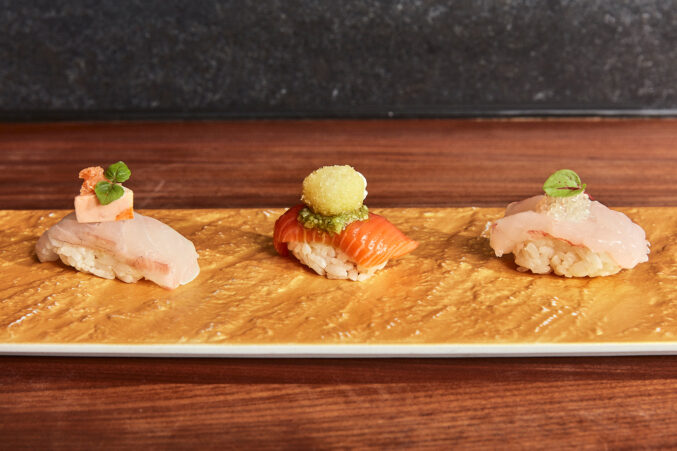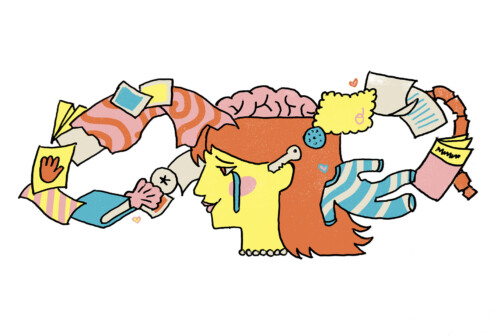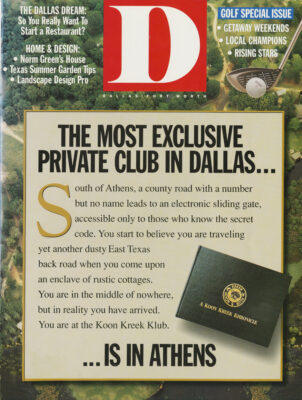We’re a busy, practical bunch here in the Dallas-Fort Worth area. Sure, we like art. but we like it to keep in its place, not get in the way. Outdoor sculpture is often slipped into nooks, designed to be part of the architectural scheme of things or it’s so simple we walk past it without actually having it register as art.
Refocus your eyes a little, though, and you’ll spot sculpture at every turn.
To get you started seeing art in less-obvious spots, we’d like to point out some outdoor pieces worth a pause. For more, pick up A Comprehensive Guide to Outdoor Sculpture in Texas by Carol Morris Little (University of Texas Press).
Name Dropping
There are a number of artists represented in Dallas and Fort Worth whose names are familiar even to the art neophyte.
One of Henry Moore’s largest and most important works is “The Dallas Piece.” three massive hunks of bone-shaped bronze outside City Hall, at Akard and Young streets. They have been restored and cleaned of carved initials (new security cameras should discourage such behavior).
One Bell Plaza, 208 S. Akard St., is home to a couple of perpetually rotating rectangles titled “Two Open Rectangles Horizontal.” The sculptor who set them spinning, George Rickey, is considered “the father” of kinetic art. Also in One Bell Plaza is a neon piece, unimaginatively titled “Neon for Southwestern Bell” by Stephen Antonakos, an important neon artist-he outlined The Modern Art Museum of Fort Worth with light in 1974.
In Fort Worth, Henri Matisse’s “Back I,” “BacK II,” “Back III” and “Back IV-created between 1909 and 1930-together are a progressive abstraction of a figure. The bronzes are installed in tranquil Burnett Park, bound by 7th, West, 10th and Lamar streets. The figures’ backs are turned on another important name across the street: Isamu Noguchi, who created “The Texas Sculpture,” three abstracts of carved Japanese granite. Noguchi is the artist who designed the seminal ’60s amoeba-shaped coffee table.
Alexander Calder is known for art that moves (he invented the mobile), but his work also stands still, too, especially in large scale on city streets. Look for “The Eagle”-a soaring red structure- at 5th and Throckmorton streets in Fort Worth. Calder’s 100th birthday is next year, so expect to hear his name a lot in coming months.
Cool Contemporaries
Driving into downtown Dallas from the east, you might think you’re passing the neglected remains of some long-forgotten construction, but it’s actually Los Angeles artist Robert Irwin’s “Portal Park Dallas.” The blade-thin Cor-Ten steel fence crosses Pearl Street and cuts through mounds of earth at Pearl, Pacific Avenue and North Central Expressway. In the 1960s, Irwin was a pioneer in what is now called the “Light and Space Movement.”
Walter Dusenbery’s twist of red Turkish marble at Bryan and Harwood streets is one of those artworks so understated you have to make yourself look to see it. Likewise Dimitri Hadzi’s massive granite “Bishops Triad” at 350 N. St. Paul St.
You can’t miss “Venture,” though. That huge, red, precarious-looking number outside 901 Main St. is by Alexander Liberman, a favorite in many cities for outdoor sculptures.
They paved a parking lot and put up some paradise. Pegasus Plaza at Akard and Main, but this is more than a nice place fora bag lunch. The inter-esting environmental sculpture by Brad Goldberg makes mythical references with carved granite, steaming limestone fissures and fountains.
“De Musica,” outside The Morton H. Meyerson Symphony Center, is by Eduardo Chillida, one of Spain’s leading sculptors. The branches at the top of the columns represent music, sculpture and architecture-close but not quite touching.
Head up to 1501 Spring Valley Rd. to check out the humongous but strangely soothing twist of steel called “Upbeat” by Clement Meadmore. Not far away, at 15303 Spring Valley, is Charles Ginnever’s red, leaning “Pisa,” although it’s looking a little tired right now.
Creative Critters
The huge new giraffe sculpture at the Dallas Zoo looms over Interstate 35, his tongue reaching for invisible leaves. Thank Dallas Morning News columnist Larry R. Powell-he’s the fellow who pointed out that it was just a lick short of being the tallest statue in Texas. Artist Bob Cassilly added another foot to the tongue, now 40 inches long, so that at 67 feet-6 inches, the giraffe stands taller than Huntsville’s statue of Sam Houston.
“A Long Way Home” by Texan Harold Clayton is a herd of five hefty cows-four of marble, one of stone-that hang out in Trinity Lake Park at Sylvan Avenue. Other larger-than-life bovines and their cowboy keepers are outside the Dallas Convention Center at Young and Griffin streets. “Trailing Longhorns” by Glen Rose artist Robert Summers thundered in on controversy (developer Trammel! Crow sidestepped the Public Art Committee to place the massive piece) but has become a tourist favorite, as predicted.
Kids love to clamber on the tusks of the “The Dallas Mammoth” by Tom Tischler, outside the Dallas Museum of Natural History in Fair Park. The Fort Worth Museum of Science and History, in that city’s museum district, has a couple of life-size steel dinosaurs out front, but a more creative creature is ’round back: the steel “Galapagos Tortoise” by Jon G. Bedford with its shell fashioned of car bumpers. John Kearny also combined amphibians and bumpers for a meeting of the frogs in “The Quorum,” also at 901 Main St. in Dallas.
The rusted steel “Pegasus” outside Booker T. TVashmgton^chooT for the Arts at Flora and Fairmount streets was built in 1984 by students, teacher Jerry Daniels and local artist Stuart Kraft. “Bandit,” a puppy of oil drums, was created by 1989 graduate Shawn Smith. ’ Spirit of 1989. ” the totem-like limestone sculpture nearby, was created by Patsy Eldridge’s sculpture class working with artist Sandi Stein.
Horses are an eternal theme in sculpture, and “The Mustangs of Las Colinas” by Robert Glen, at 1215 N. O’Connor, is one of the world’s largest horse sculptures. Perhaps they started out looking like Polish artist Anna Debska’s -Colts in Motion,” a happy herd of gangly colts frolicking in the shadows of 717 N. Harwood St.
Pretty People
The children of David Cargill’s “Playtime,” in verandah Park behind the Wyndham Anatole on Interstate 35 (go through the hotel lobby), are enjoying a good romp on the lawn. Nearby, “Sharing,” by J. Seward Johnson Jr., is a moment of Rockwell-esque Americana.
More of Johnson’s life-size figures turn up on the streets of downtown Dallas: street sweeper “Aftermath,” at 2001 Bryan; artist “The Right Light,” at the corner of Flora and Olive; and meter reader “Time’s Up,” at Harwood and Wenched. They’re occasionally rotated to different locations.
The sculpture collection of Dallas’ Market Center is scattered in its parking lots. For a dose at joie de vivre, look for “Laughing Man” by Harry Marinsky and “Singing Man” by Elizabeth Turolt.
Mark Macken’s “April,” in Samuell-Grand Park, appears to be welcoming a spring breeze. She’s oh-so~sweet, but a few yards behind her, “Mirror Image,” by Barrett DeBusk of Fort Worth, is just plain unnerving.
Macken also caught Lot’s Wife in her defining moment and placed her in Stone Place, a walkway between Elm and Main streets in downtown Dallas.
Get our weekly recap
Brings new meaning to the phrase Sunday Funday. No spam, ever.
Related Articles

Local News
Bill Hutchinson Pleads Guilty to Misdemeanor Sex Crime
The Dallas real estate fun-guy will serve time under home confinement and have to register as a sex offender.
By Tim Rogers

Restaurants & Bars
The Best Japanese Restaurants in Dallas
The quality and availability of Japanese cuisine in Dallas-Fort Worth has come a long way since the 1990s.
By Nataly Keomoungkhoun and Brian Reinhart

Home & Garden
One Editor’s Musings on Love and Letting Go (Of Stuff, That Is)
Memories are fickle. Stuff is forever. Space is limited.
By Jessica Otte


